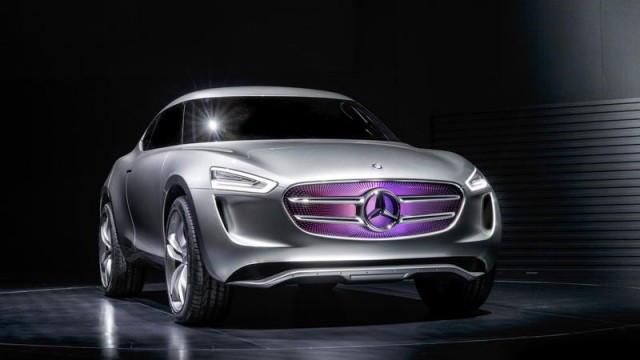Say hello to the G-Code, the first signs that Mercedes-Benz is set to join the ever growing baby crossover market. Unveiled at the opening of the company's Chinese R&D Centre in Beijing, the G-Code could arrive at the same time as the forthcoming Audi Q1 to do battle with the Nissan Juke et al.
Exterior
Described as a '2+2-seater Sports Utility Coupé' the G-Code is 32cm shorter than the Mercedes-Benz GLA crossover, which puts it squarely into the Juke's segment. The styling, despite being led by the team in China for Chinese metropolises, was overseen by those in Sindelfingen so could be 'Europeanised' if given the green light.
Like the BMW i3 the G-Code features rear-hinged 'suicide' doors with the B-pillar integrated into the doors themselves. The A-pillars have also been minimised to give a wraparound windscreen that should lead to ample visibility. The traditional Merc two-slat grille is retained in terms of appearance, but behind the tri-pointed star is a digital display that changes colours depending on the driving mode: blue in normal driving, purple for hybrid and red for sport mode.
The paintwork on the G-Code is described as 'multi-voltaic silver' and is said to be capable of acting as a giant solar cell for harvesting power from the sun and also as an electrostatic panel, turning air moving over the surface of the car into electricity.
Interior
Mercedes is really getting into the whole 'connected' world with the G-Code. Instead of a key you use your smartphone to unlock the car and a dock in the centre console unlocks the driving controls. The steering wheel and pedals extend towards the driver and his leather clad carbon fibre seat from their rest position ready for the off, the steering wheel unfurling like a butterfly from its place within the dashboard itself.
The air vents and information display also take part in this 'coming out to play' game and the display spans almost the entire width of the instrument panel with images from the rear-view camera showing up near its edges.
In addition to the rear view camera the G-Code is also equipped with 360-degree monitoring of the surroundings via 3D cameras, radar, an infra-red scanner and GPS data, all of which can combine to communicate with nearby traffic infrastructure and other vehicles in the vicinity to circumvent traffic jams.
Mechanicals
Mercedes says that the powerplant at the heart of the G-Code, like that of the Ener-G-Force and GT6 vehicle studies 'makes absolutely no claim to be implemented within foreseeable periods' so cue wildly speculative concept power.
No the G-Code is not powered by 'Unobtanium', but rather hydrogen in a 'state-of-the-art' (for a made up powerplant) turbocharged combustion engine that powers the front wheels with rear axle mounted electric motor powering the rear. This set up means the G-Code can run as a hydrogen powered front-wheel drive car, an electric powered rear-wheel drive one or - by engaging a "digital prop shaft" - an all-wheel drive one.
Anything else?
The G-Code was unveiled at the opening of Mercedes-Benz's new €13.5 million Advanced Design Studio and R&D Centre in Beijing, China. The facility is part of a total €112 million investment in China by Mercedes and will, in time, house some 500 engineers and designers.
"For the automotive industry, China has become the most important market worldwide. The country is truly in fast forward mode - we recognize this importance and reflect it in our local R&D activities, which we are clearly pushing forward to the next level," says Hubertus Troska, Member of the Board of Management of Daimler AG responsible for China. "As a key element for our sustainable growth strategy in China, our new R&D Centre will help us to fully tap our potential here and give our Chinese customers' voice even more weight in our global network and future product development."

